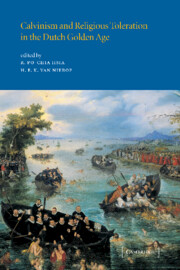Book contents
- Frontmatter
- Contents
- Notes on contributors
- 1 Introduction
- 2 ‘Dutch’ religious tolerance: celebration and revision
- 3 Religious toleration in the United Provinces: from ‘case’ to ‘model’
- 4 The bond of Christian piety: the individual practice of tolerance and intolerance in the Dutch Republic
- 5 Religious policies in the seventeenth-century Dutch Republic
- 6 Paying off the sheriff: strategies of Catholic toleration in Golden Age Holland
- 7 Sewing the bailiff in a blanket: Catholics and the law in Holland
- 8 Anabaptism and tolerance: possibilities and limitations
- 9 Jews and religious toleration in the Dutch Republic
- 10 Religious toleration and radical philosophy in the later Dutch Golden Age (1668–1710)
- 11 The politics of intolerance: citizenship and religion in the Dutch Republic (seventeenth to eighteenth centuries)
- Select bibliography
- Index
2 - ‘Dutch’ religious tolerance: celebration and revision
Published online by Cambridge University Press: 08 July 2009
- Frontmatter
- Contents
- Notes on contributors
- 1 Introduction
- 2 ‘Dutch’ religious tolerance: celebration and revision
- 3 Religious toleration in the United Provinces: from ‘case’ to ‘model’
- 4 The bond of Christian piety: the individual practice of tolerance and intolerance in the Dutch Republic
- 5 Religious policies in the seventeenth-century Dutch Republic
- 6 Paying off the sheriff: strategies of Catholic toleration in Golden Age Holland
- 7 Sewing the bailiff in a blanket: Catholics and the law in Holland
- 8 Anabaptism and tolerance: possibilities and limitations
- 9 Jews and religious toleration in the Dutch Republic
- 10 Religious toleration and radical philosophy in the later Dutch Golden Age (1668–1710)
- 11 The politics of intolerance: citizenship and religion in the Dutch Republic (seventeenth to eighteenth centuries)
- Select bibliography
- Index
Summary
When foreigners visit the Netherlands today, certain items seem invariably to stand on their touristic agenda: the Rijksmuseum, Anne Frank's house, a boat ride through the canals. One of the more remarkable items is a walk through Amsterdam's red light district, where, on a typical summer evening, in addition to the clientele, thousands of foreigners throng – men, women, couples, even families. Such districts are not usually on the itinerary of respectable tourists, but in Amsterdam a promenade there serves a purpose: foreigners are invited to wonder at the tolerance – or, if you prefer, permissiveness – that prevails in the Netherlands. In the same district but during the daytime, the Amstelkring Museum extends essentially the same invitation. The museum preserves Our Lord in the Attic, one of the roughly twenty Catholic schuilkerken, or clandestine churches, that operated in Amsterdam in the latter half of the seventeenth century. Nestled within the top floors of a large but unremarkable house named The Hart, Our Lord does not betray its existence to the casual passer-by – it has no tower, no stained-glass windows, no crosses on the outside – and, but for the museum banner that hangs today on the building's front façade, one could easily pass by it unawares. In its day, though, its existence was an open secret, like that of the other schuilkerken. Its discreet architecture fooled no one, but did help to reconcile the formal illegality of Catholic worship with its actual prevalence.
- Type
- Chapter
- Information
- Publisher: Cambridge University PressPrint publication year: 2002
- 10
- Cited by



